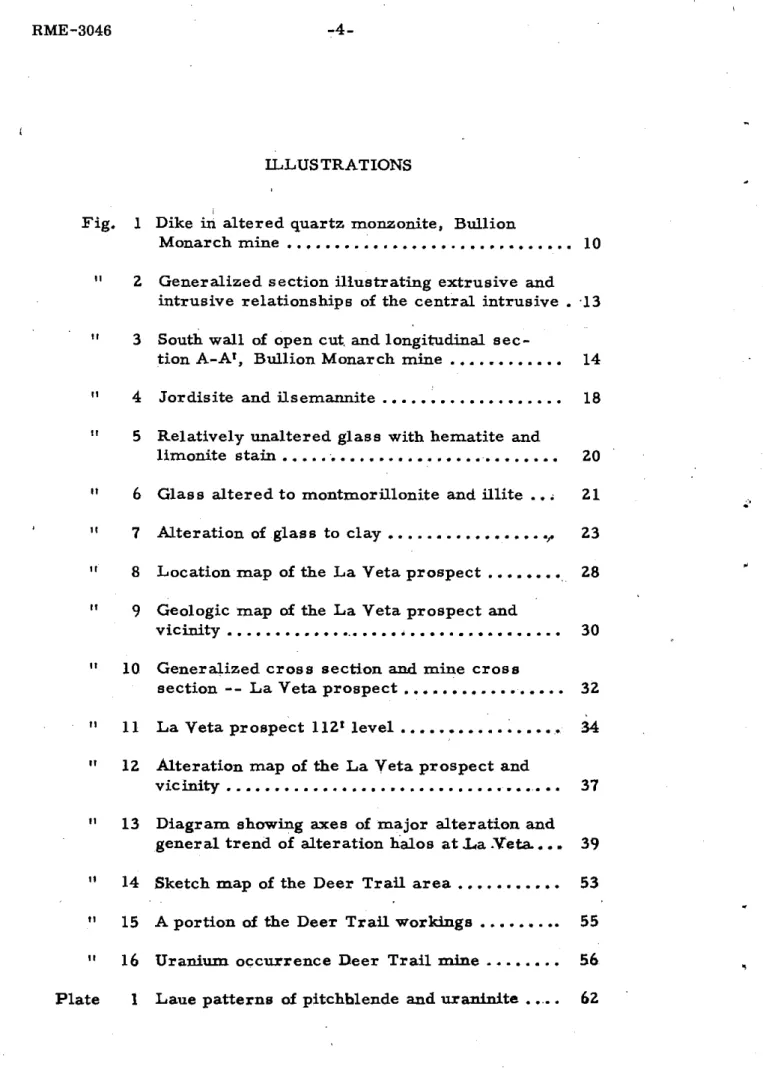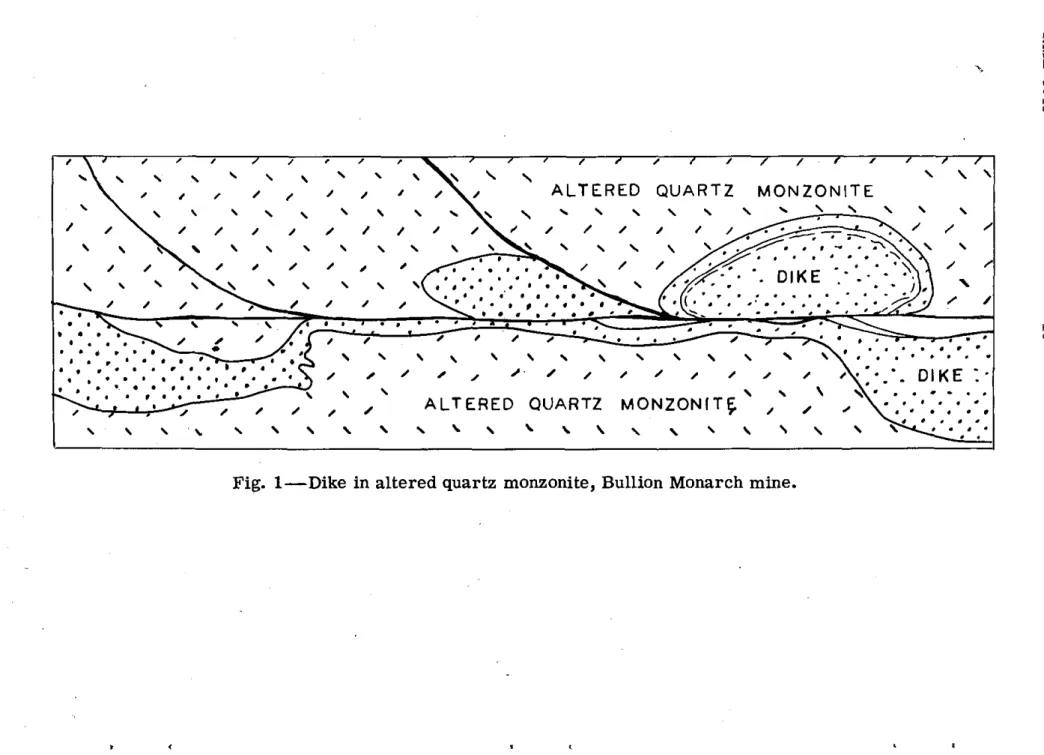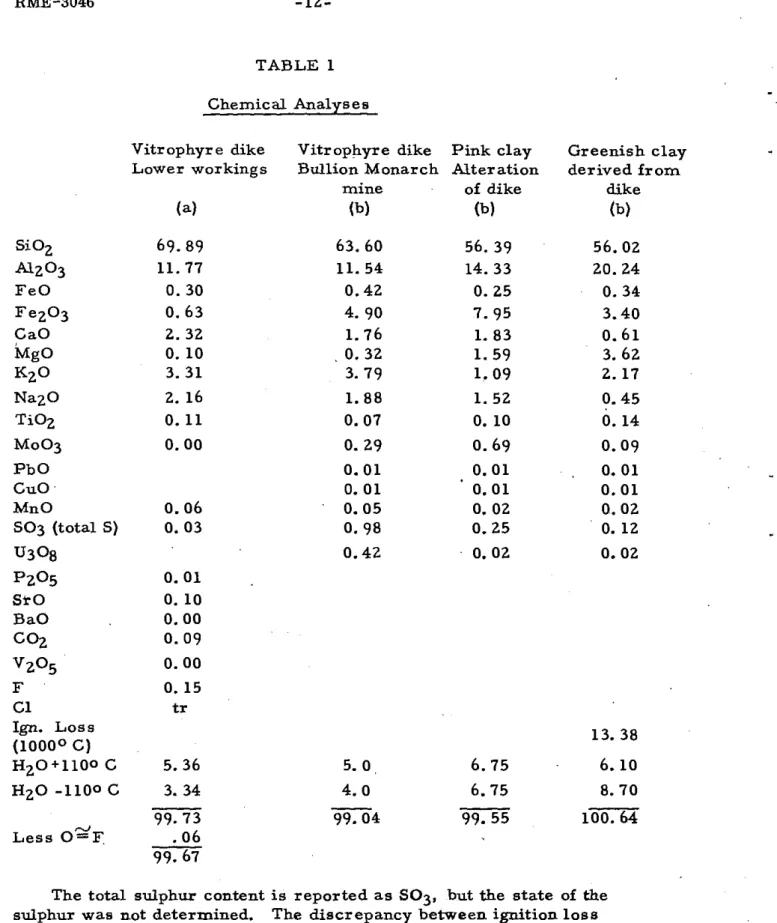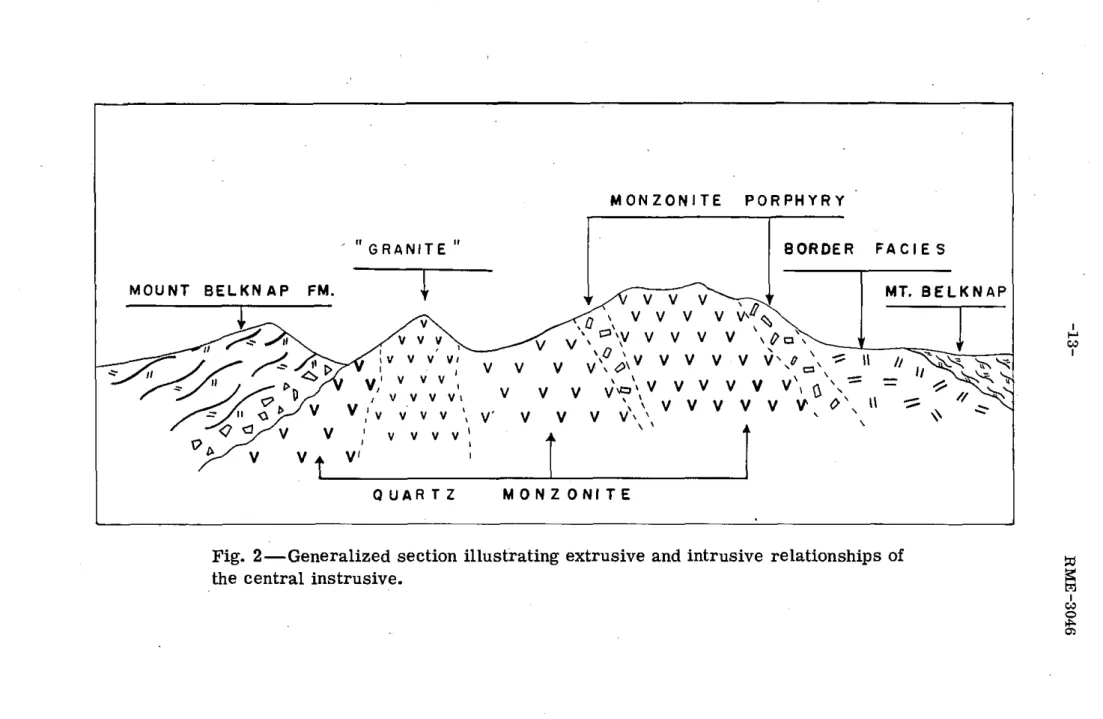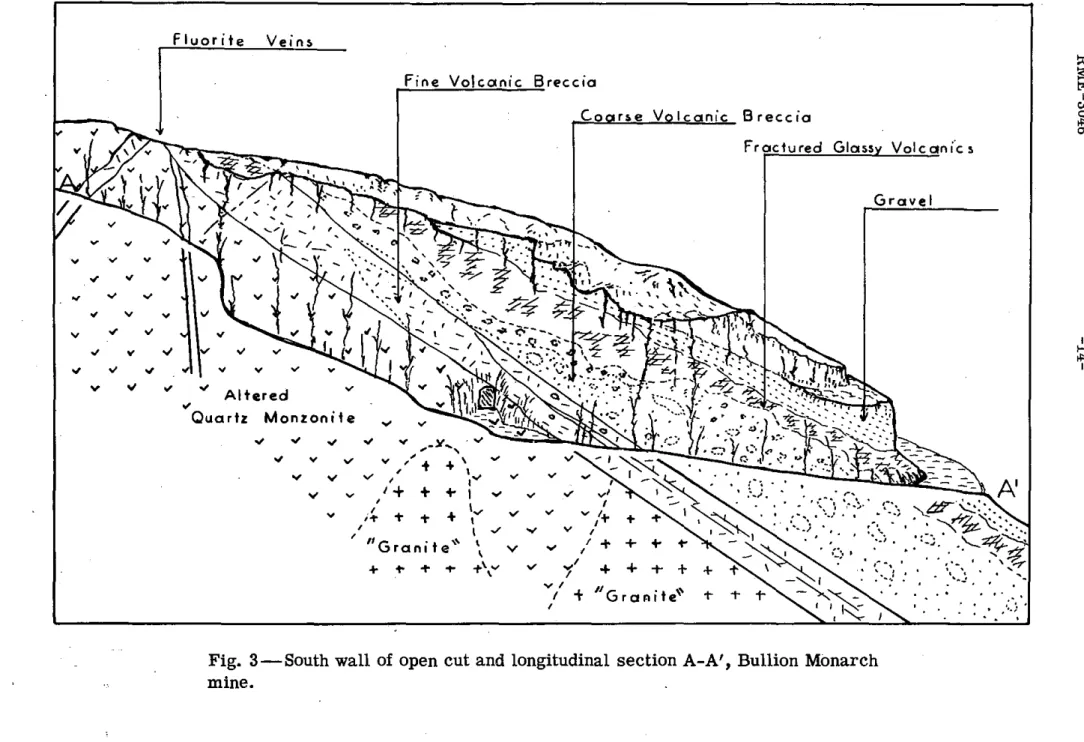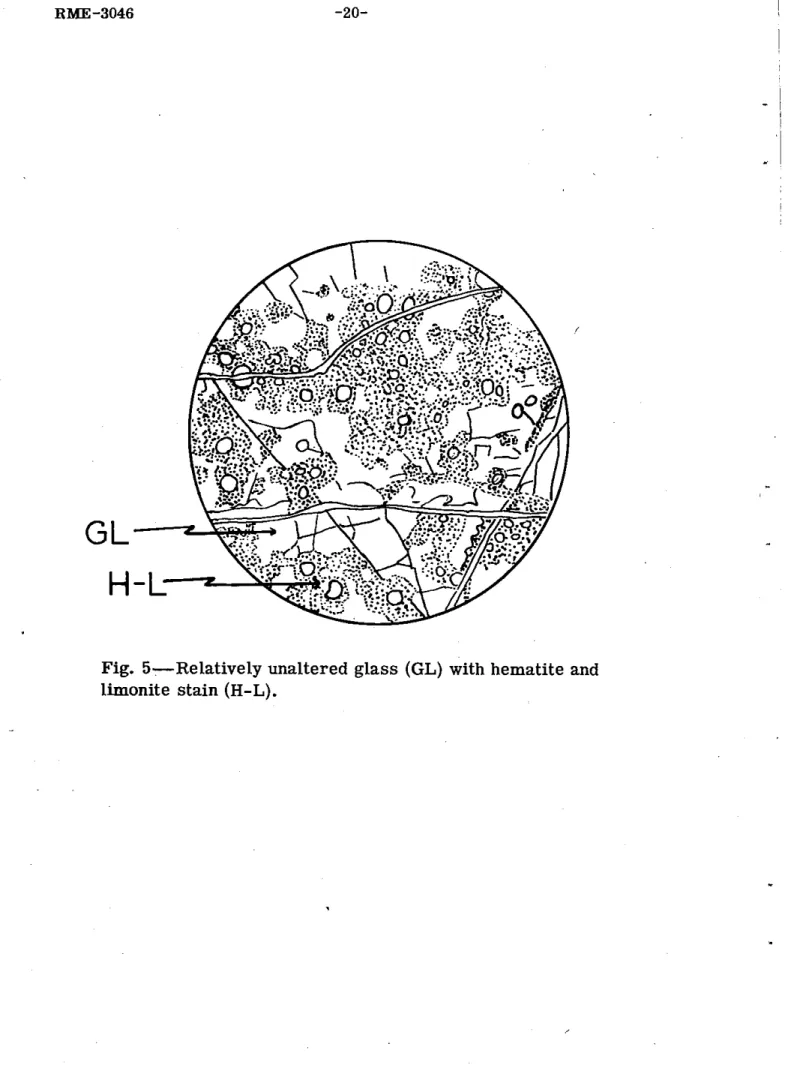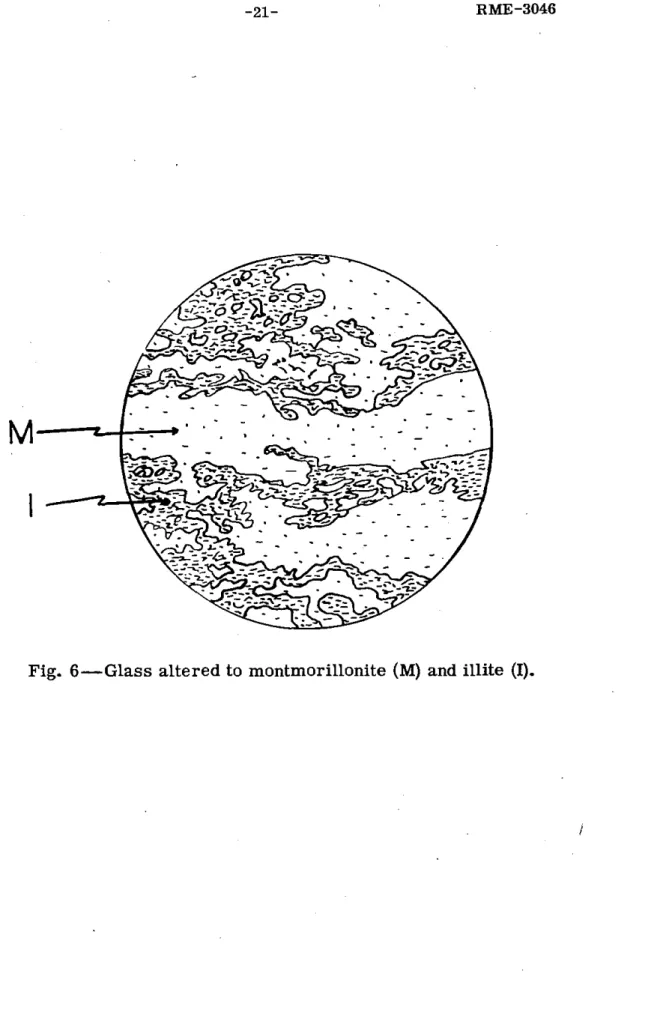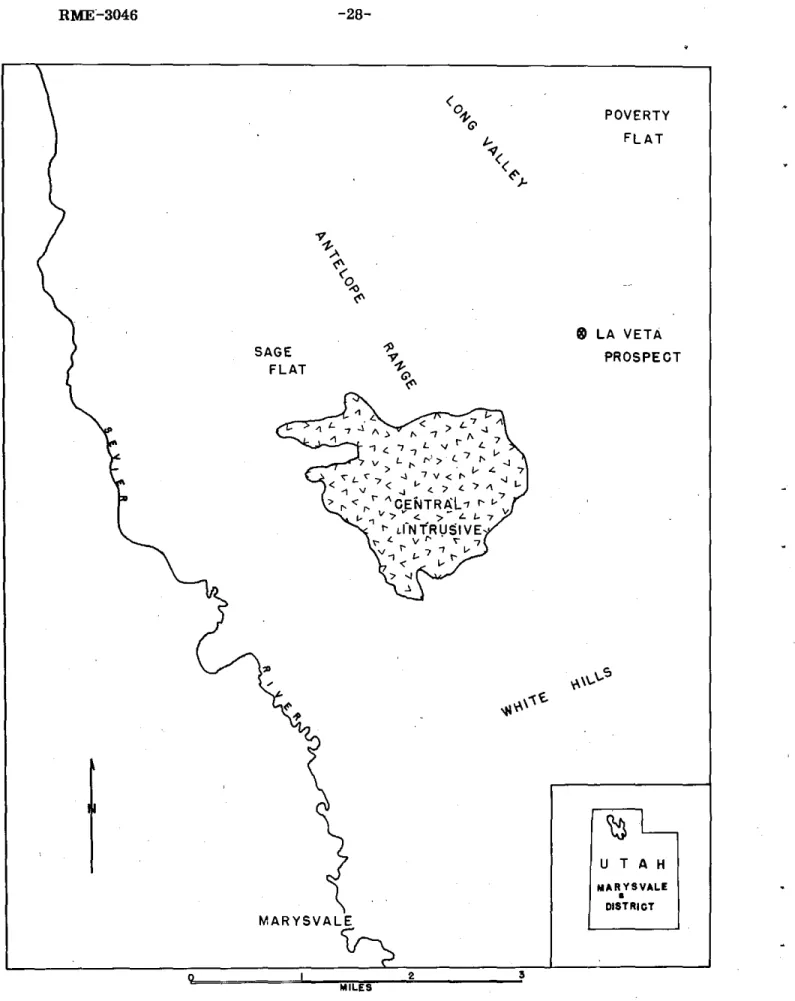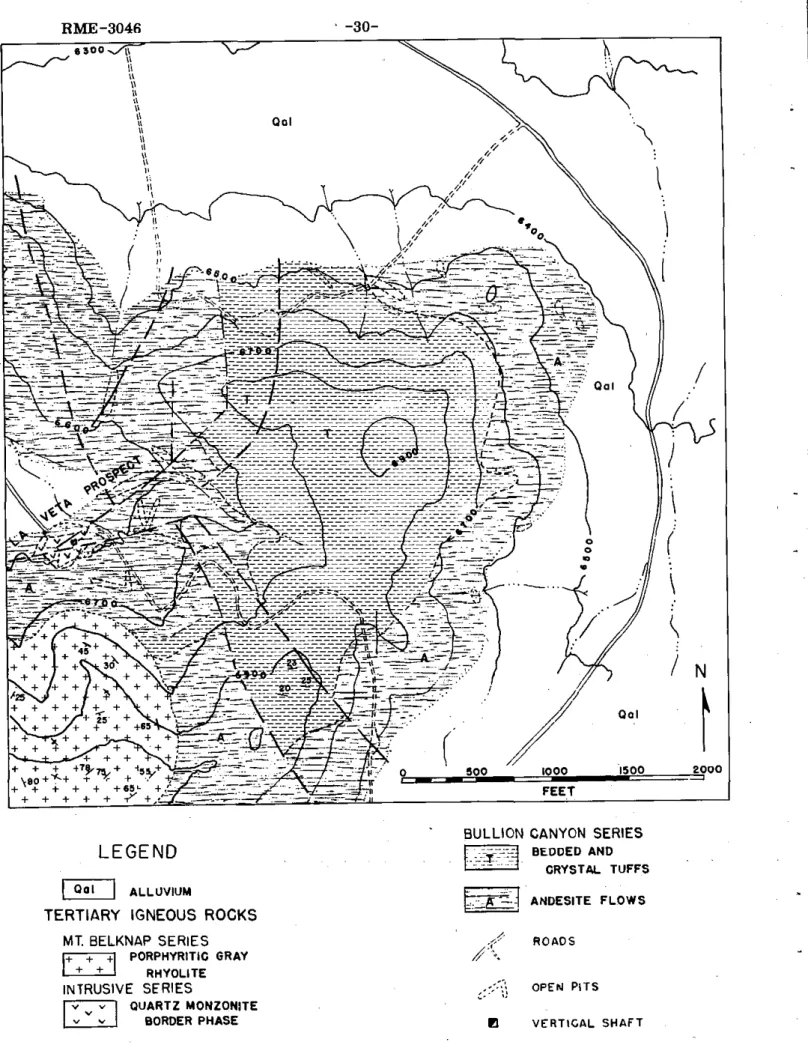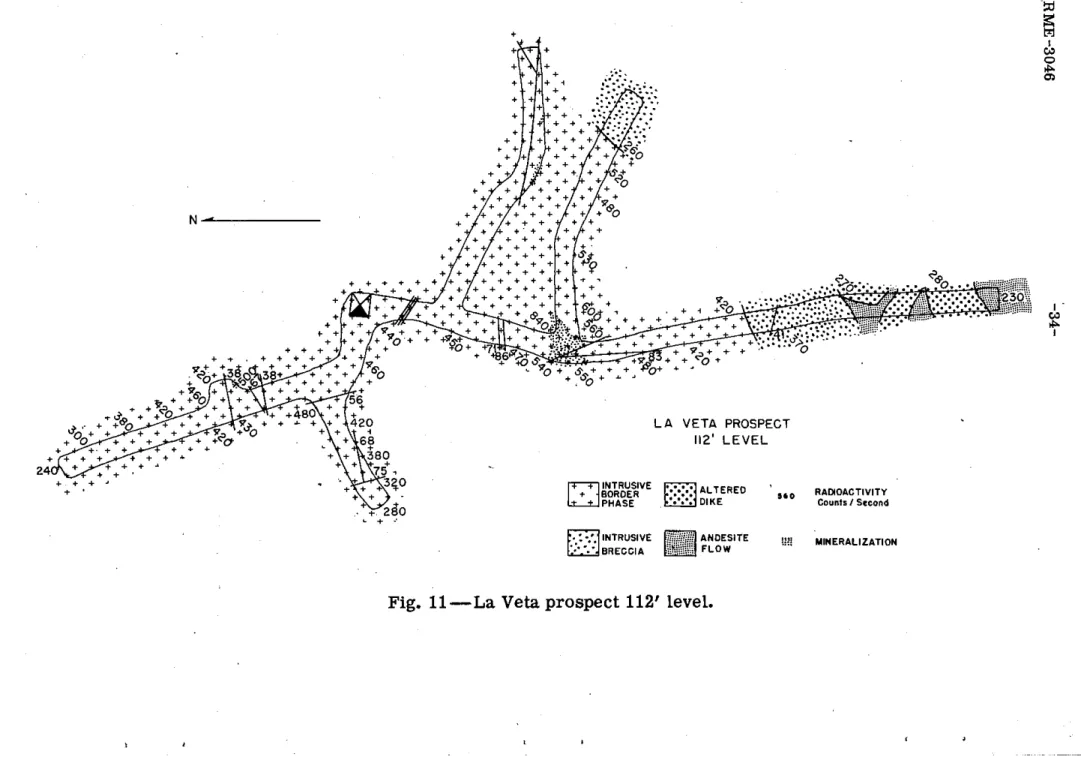UNITED STATES ATOMIC ENERGY COMMISSION
RME-3046
ANNUAL REPORT FOR JUNE 30, 1952 TO
APRIL 1, 1953
By
Paul F. Kerr
P. K. Hamilton
Gerald P. Brophy
W. L. Simpson
April 1953
Columbia University
William Cohen
Henry Dahl
Jack Green
RME-3046
GEOWGY AND MINERALOGY
The United States Atomic Energy Commission makes no representation or warranty as to the accuracy or completeness of the information herein and makes no
recommendation concerning it.
In the interest of economy. this report has been reproduced direct from copy as submitted to the
Technical InformatiOD; Service.
Work performed under under Contract No. (AT -30-1-702).
AEC, Oak Ridge. Tenn.-W32610
-2-- -2-- - - · - -•i
I
I ••
I
• TABLE OF CONTENTS
illustrations . . . • . • • . . . • . . . • . . . • • . . Alteration of a vitrophyre dike, Bullion Monarch
mine, Marysvale, . Utah . . • • • . . . • . . . . • . . . The La Veta prospect near Marysvale, Utah •..•.... Hydrous uranium molybdate in Marysvale ore . . . . Deer Trail area, Marysvale, Utah . . . • . . . • A note on pitchblende and uraninite ...• -• . . . . • . . . • . . •
Radioactive features
of
vein minerals, Prospectormine, Marysvale, Utah .•.•.•..•..•.•.••.•••••• Geochemical aspects of alteration, Marysvale,
Utah . . . .
Page
4
45
RME-3046
-4-ILLUSTRATIONS
'
Fig. 1 Dike in altered quartz monzonite, Bullion
Monarch mine ... 10
11 2 Generalized section illustrating extrusive and
intrusive relationships of the central intrusive • ·13
11 3 South wall of open cut. and longitudinal
sec-tionA-A', Bullion Monarch mine •••.••.•.••• 14
11
4
Jordisite and ilsemannite .••••••..•.•.••.•.• 1811 5 Relatively unaltered glass with hematite and
limonite stain . . . · ... 20
11 6 Glass altered to montmorillonite and illite •• , 21
.;;·
11 7 Alteration of glass to clay ••...•.•.•••••••• ,. 23
11 8 Location map of the La Veta prospect .•••••••. 28
11 9 Geologic map of the La Veta prospect and
vicinity ... 30
11 10 Generalized cross section and mine cross
section -- La Veta prospect .•••••••••••.•••• 32
11 11 La Veta prospect 1121 level ••••••••••••••••• 34
11 12 Alteration map of the La Veta prospect and
vicinity ... •-• •. 37
11 13 Diagram showing axes of major alteration and
general trend of alteration halos at .La .Veta. ••• 39
11 14 Sketch map of the Deer Trail area •••.•.••••• 53
11 15 A portion of the Deer Trail workings ••••••.•• 55
11 16 Uranium occurrence Deer Trail mine .•.•.•.• 56
THE CONTRACT PROGRAM by
Paul F. Kerr
Contract AT(30-1)702 between the Division of Raw Materials, Atomic Energy Commission and Columbia University has been con-cerned with field and laboratory studies of primary uranium-bearing veins and associated alteration features. Of late the veins in the vicinity of Marysvale, Utab, representing the principal vein deposits in the U.S., have absorbed a major part of the research effort under the contract. Earlier laboratory studies based on visits to Canadian localities have been held in abeyance pending the development of mass
spectrographic techniques for age determination at the Lamont
Geol-ogical Observatory under a separate contract. An account of studies
on the primary uranium-bearing veins in the Sunshine mine, Idaho, is in press and scheduled to appear in the Transactions of the American Institute of Mining and Metallurgical Engineers within a few
rrionths-Several reasons have determined the selection· of the Marysvale area for special study. The effects of hydrothermal alteration, with which uranium has been shown to be associated in part, are among the· most widespread to be observed in the West. The central producing area is small compared with a wide zone in which prospecting has been active, hence it is essential to have information conce,.rning the nature of the alteration, its significance, the character of the distribution and the possible correlation with uranium deposition which may be applicable to the wider zone. Further, Marysvale occupies a geographic position which is unique along the boundary between the gr.eat belt of uranium-producing sediments of the Colorado- Utab Plateau and the Basin and Range province of Utab and Nevada. It is here that answers may perhaps be found to some of the basic questions on origin which affect the focus of exploration in a wide area.
Due to the complexity of the volcanic history of the area and the extent of the alteration effects, the Marysvale study has been undertaken in several stages. During the period November 1951 to .January 1952 ten preliminary reports were released dealing with significant prospect areas more or less surrounding the central mining area. In addition, the annual report for the period .July 1; 1951 to .June 30, 1952 comprised a geologic guide to the Marysvale area. It was the purpose of these re-ports to make available data as assembled particularly for the benefit of
RME-3046
-6-local geologists, mine operators and prospectors. As these reports were issued, progress was being made on an alteration map of the area and a geologic map adequate to serve as a base for the alteration study.
In the intervening periods between field seasons laboratory studies have
gone forward at the University to establish basic data for field inter-pretations.
The current report as a progress report includes a number of recently completed features mostly devoted to the Marysvale area, but in considerable measure of more than local significance.
MEMORANDA OR REPORTS APPLYING TO THE MARYSVALE AREA
RM0-832 Preliminary Memorandum, East Slope Area, Marysvale,
Utah. Jack Green and Paul F. Kerr, November, 1951, pp. 1-18.
RM0-833 Preliminary Memorandum, Papay's Hope Prospect,
Marys-vale, Utah. Gerald P. Brophy and Paul F. Kerr, November 6, 1951, pp. 1-11.
RM0-860 Preliminary Memorandum on the Dark Horse and Saturday
Areas, Marysvale, Utah. Louis E. Woolard and Paul F. Kerr, November, 1951, pp. 1-15 .
•
RM0-862 Preliminary Memorandum on the Scorpion Area, Piute County,
Utah. Harry M.- Dahl and Paul F. Kerr, December, 1951,
pp. 1-14.
RM0-863 Preliminary Memorandum on the Flat Tire Prospect,
Marys-vale, Utah. Gerald P. Brophy and Paul F. Kerr, December, 1951, pp. 1-ll.
RM0-864 Preliminary Memorandum on the Trinity Mines, Marysvale,
Utah. Jack Green and Paul F. Kerr, December, 1951, pp.
1-12.
RM0-.885 Preliminary Memorandum· on the Beaver Creek Area,
Marys-vale, Utah. Louis E. Woolard and Paul F. Kerr, January, 1952, pp. 1-15.
RM0-887 Preliminary Memorandum on Big Rock Candy Mountain. Jack Green and Paul F. Kerr, January, 1952, pp. l-38.
RM0-893 Preliminary Memorandum on the White Horse Area, Piute
County, Utah. Harry M. Dahl and Paul F. Kerr, January, 1952, pp. l-20.
RM0-924 Annual Report for July l, 1951 to June 30, 1952, Part l.
A Geologic Guide to the Marysvale Area. Paul F. Kerr, Gerald P. Brophy, Harry M. Dahl, Jack Green, Louis E. Woolard, May, 1952, pp. l-57.
RME-3046
-8-ALTERATION OF A VITROPHYRE DIKE, BULLION MONARCH MINE, MARYSVALE, UTAH
by
Paul F. Kerr and P. K. Hamilton ABSTRACT
One of the vitrophyre dikes with associated radioactivity which cuts quartz monzonite in the Bullion Monarch mine, Marysvale, Utah, has been studied in detail. Field evidence indicates that the dike was · emplaced after the erosion of the intrusive quartz monzonite and
re-lated rocks, and that it represents a member of a feeder system which contributed to the overlying Mount Belknap volcanic series. The dis-tribution of thin veinlets and disseminated spots of uranium mineral-ization points to greatest precipitation either with the emplacement of the dike or early in the progressive hydrothermal alteration. The radioactive uranium mineral, on the basi's of partial laboratory data, is tentatively identified as a fine, sooty uraninite mixed with purple
fluorite of comparable fineness together w~th pyrite. Other vein
min-erals include jordisite and ilsemannite. Associated oxidized minmin-erals are autunite, limonite, and hematite. The dike consists of fairly f:resh glass, glass altered to montmorillonite, and highly altered clay con-sisting of a mixture of montmorillonite and illite. The three appear to have been formed in the order named.
ACKNOWLEDGMENTS
It is a pleasure to acknowledge the cooperation of Dr. Philip L. Merritt, Dr. Donald L. Everhart and Mrs. Muriel Mathez of Raw Materials Operations, and Dr. C •. J. Rodden, Chief Chemist of the Microchemical Division of the Atomic Energy Commission, who is responsible for chemical determinations. We also wish to acknowledge the chemical analysis made by E. H. Oslund directed by Professor S. S. Goldich of the Rock Analysis Laboratory, University of Minnesota. We are indebted to Dr. Lloyd W. Staples of the University of Oregon for a comparison specimen containing ilsemannite and jordisite.
GEOLOGY
Mining operations at Marysvale, Utah, in the summer of 1951, dis-closed an unusual dike with associated radioactivity. The occurrence lies along a branch of an adit below the main open cut of the Bullion Monarch mine. It is thought that the vitrophyre dike was emplaced after the erosion of the intrusive quartz monzonite and related rocks. · Subsequent study in-dicates that such dikes represent part of a feeder system which contributed to the overlying Mount Belknap volcanic series.
The dike under consideration varies from a few inches to about two feet in thickness and is believed to be representative of a number of
oc-currences in the area. It is more or less vertical and consists in places
of elongated, elliptical segments presumably isolated in part from the original thin narrow dike, either by deformation or the vagaries of in-trusion. A sketch of the dike pattern as it appears along the back of the
drift is shown in Figure 1.
The dike cuts altered quartz monzonite, which is well exposed in the workings •. The latter, along with a fine-grained aplitic rock-- locally called "granite" -- constitutes the principal host rock in the mine. The significance of the dike with respect to the uranium occurrence is a matter of interest. Along the dike evidence indicates the greatest precipitation of uranium mineralization either with the emplacement of the dike or at an early stage of the subsequent hydrothermal alteration,
Both the altered quartz monzonite and aplite, in which to date the uranium ores have been chiefly found, are generally recognized a,s late
Tertiary in age. The intrusion was followed by a period of erosion and
a series of late Tertiary volcanic rockll was deposited upon the erosion surface; volcanic glass and agglomerate lying in places at the base, and
massive flows above. These general relationships are shown in Figure 2.
The volcanic sequence has been designated by Callaghan (1939) as the Mount Belknap volcanic series. Figure 3 shows a longitudinal section along the south wall of the Bullion Monarch open cut.
The Mount Belknap sequence probably was developed in several. stages. Hence, until the immediaJ;e contact between the dike and the base of the volcanics is exposed, it will not be clear whether the intrusive
served to feed basal portions of the Mount Belknap or contributed to
higher levels of emplacement.
In
any case dikes cut the intrusive andapparently served as conduits along which volcanic materials rose. Field investigations carried on during the summer of 1952 by L. E. Woolard indicate that the flows outside the immediate area of the Bullion Monarch mine are composed of rhyolite, portions o£ which have
mega-1:0
;;::
'·
l;j I c.o 0"'"
"'
,
,
'
'
,
,
'
,
,
,
,
/,
'
,
'
, ,
'
'
/'
' '
'
'
' '
'
'
'
" "
"
,
ALTERED QUARTZ MONZONITE'
'
'
'
'
'
'
'
'
'
....'
'
'
'
'
/ / / / / / / / / / / / / /' '
'
'
'
'
'
'
'
'
,
"
/"
/,.
"
,
/ /'
'
'
,.
'
'
'
'
'
.
•
•
..
DIKE /'
/"
/ /,
• •
• • • ••
•'
1-' I /,
,
"
, , ,
,
/ 0•
• I'
'
'
'
'
'
• ••
'
'
'
'
'
'
'
/ /,..
/ / DIKE. .
•.
/,
/ / / /"
/"
.
•
•
•
•'
\•
'
'
'
'
,
/ /,
/,
/ ALTERED QUARTZ MONZONIT~ / /"'
•
'
'
'
'
'
'
'
'
'
'
'
' '
'
'
'
'
'
'
'
'
'
scopic features that are similar to certain parts of the dike within the mine. On the lower level of the Bullion Monarch mine the center of the dike appears to be similar to that of portions of the extrusives.
Both the association of uraninite with a dike and subsequent alteration support the conclusion that part of the mineralization and alteration was as recent in the history of the Marysvale sequence as Mount Belknap.
MINERALOGY OF THE VITROPHYRE DIKE
The dark yellow-brown glass is dense, brittle and easily fractured. It is inter layered with medium to light gray bands. Nearby at the heading of the drift, dike material is altered to a solid mass of greenish clay, and various stages in the progress of the alteration to plastic clay are observ-able.
Both the glass and the bands are arranged in flow lines, and
occa-sionally show swirls.
In
thin section, brown layers of volcanic glassalternate with the lighter gray bands which are composed of minutely crystalline quartz and a fine feldspar, probably orthoclase. Under the
microscope it is possible to observe both spherulites and circular areas
which appear to be a denser glass, perhaps representing incipient crys-tallization at the time of emplacement. The glass and the spherulites are both fractured, and these fractures, particularly the larger ones, are filled with an intimate mixture of secondary gypsum and quartz. A red iron stain appears to be localized principally along these fractures, where it frequently borders the gypsum-quartz fracture fillings. Asso-ciated with the stain is a small amount of uraninite intimately mixed with pyrite·, which seems to be localized in the stained areas. Purple fluorite is concentrated in the coarser quartz bands which appear to be more permeable.
The clay derived from the dike represents a n\lmber of significant
chemical changes, shown in Table 1. The silica in both clay fractions
is less than in the original glass; however, the amount is somewhat higher than would be expected if the glass and resulting clay did not contain
finely distributed quartz.
Alumina increases with the alteration and together with magnesia furnishes the best index among the various determinations to indicate the extent of clay mineral development. The greenish clay shows a
RME-3046
-12-TABLE 1 Chemical Analyses
Vitrophyre dike Vitrophyre dike Pink clay Greenish clay
Lower workings Bullion Monarch Alteration derived from
mine of dike dike
(a) (b) {b) (b) 8i0z 69.89 63.60 56. 39 56.02 Alz03 11.77 11. 54 14.33 20.24 FeO 0.30 0.42 0.25 0.34 Fe 2o 3
o.
63 4.90 7.95 3.40 GaO 2.32 1. 76 1. 83o.
61 MgO 0. 10 0.32 1. 59 3.62 KzO 3.31 3. 79 1. 09 2.17 NazO 2. 16 1. 88 1. 52o.
45 TiOzo.
11 0.07o.
10o.
14 Mo03 0.00o.
29 0.69 0.09 PbOo.
01o.
01o.
01 GuO·o.
01o.
01 0.01 MnO 0.06 0. OSo.
02 0.02 803 {total 8) 0.03o.
98 0.25 0. 12 u3o8 0.42o.
02o.
02 PzOs 0.01 8r0o.
10 BaO 0.00 COz 0.09 VzOs 0.00 Fo.
15 Cl tr Ign. Loss 13. 38 {1000° C) Hz0+11QO C 5.36 5. 0 6.75 6.10 HzO -110o C 3. 34 4.0 6.75 8.70 99.73 99.04 99. 55 100.64"'
. 06 Less O=F. 99.67The total sulphur content is reported as 803, but the state of the sulphur was not determined. The discrepancy between ignition loss and totp.l HzO for the greenish clay is· presumed to be within the limits
of experimental error, and the loss on ignition is computed in the total
rather than total HzO.
(a) Analysis by Rock Analysis Laboratory, University of Minnesota
MOUNT BELKNAP FM.
j
~--~l
MT. BELKNAPv v v
~. .
-l
v
0,vvvvv-..,
!
~, o'
'
'1:,..-..-
,
v
v vv v \
'Y
v v v v ,
fJ o ,"
/
'
v v • v
'
0 'v v v v v v'
'
---:;-;-'~,, ---::-"'"<~~,~ ''-~
..
,~--c:o1
~ / ' v ' V V V \ ()I , Jl c::>' , II II '""" """<
':.//-~://
~"
/~,
:_~
t>v.''
v v v ',
v
v
v v
v'>J:J\
v v v v v v\
o
',,-===
~ "~,
/ . I? • ,v v v v'
\ \
y y y y y
V'
~'
II -:;:; " 1 ~ t> V V 1 1 v v· v v \v·
v v
Vv \ \
'
\.
'\'
.:::-0P.<7-cJ V V
vvvv~
i
t
v
v
tL_v_~
_____
'---~---~J
QUARTZ MONZONITEFig. 2-Generalized section illustrating extrusive and intrusive relationships of
the central instrusive.
I
'""'
v v
"
v v v ~ v ~ v..,
"'
v v v v"'
v v vv
.,
v"'
..,
v v Fluorite Vei n• v v"'
v V' v v v,
v Altered,
Quartz Monzonite v v v'
'
Fine Volcanic Breccia
V' .., ,-'Y .... , v / t
+'
'
\ V I IV'
I+
+
+
I ~~ T+
+
11 Granite'' I., I I \ \+
...
+'"
\ v...
+
+
+
+
+
Fractured Gla•• Volcan(cs
Gravel
+
v i
t t "Granite'' t-
+
t-'
Fig. 3-South wall of open cut and longitudinal section A-A', Bullion Monarch
mine.
..
. ·
..
;.
I ......
Iamount of ferrous iron is small and the variation is probably of minor significance. The ferric iron, on the other hand, is reasonably abundant
and updergoes considerable change. The higher iron content of the pink
clay is probably due to a concentration of ferric iron in the initial stages of alteration. This is accompanied by some hydration and the develop-ment of limonite.
GaO is ·not a major constituent of either the vitrophyre or the clay. The greenish clay, however., shows a definite decrease in GaO.
The variation in K20 is of particular interest. The potash in the original vitrophyre, amounting to 3. 31%, drops to 1. 09% in the pinkish clay. With further alteration, however, the value rises to 2.17o/o. 'Ap-parently the potash is first leached from the rock and subsequently
pre-cipitated. The latter provides an index to the increase in the
potassium-bearing clay mineral. It is interesting to note that the same situation does
not apply to Na20. The latter undergoes a progressive decrease.
The variation in water content between the glass and the most highly altered clay is 0. 97% for water above 110° C. and 5. 36% for water below
ll0° C. The change for water above ll0° C. indicates a substantial w"ater
content for the original glass, but at the same·time a smaller increase accompanying alteration to clay than might be expected.
The small amount of Mo03 shown in the analyses is of interest in
view of the occurrence of the molybdenum minerals, jordisite and
ilse-mannite, in veinJ of the Bullion Monarch mine. The increase from no detectable Mo03 in the fresh glass to 0. 69% in the pink clay indicates the probable existence of molybdenum ions in the hydrothermal solutions whi.ch followed the dike formation. However, molybdenum has apparently not been concentrated in the greenish clay.
Uranium is not as abundant in the clay as in the less altered
dike.
Apparently the analyses point toward a concentration of mineralization either with the emplacement of the dike or with the first stages of altera-tion. But both U30S and S03 could have. been introduced along fine frac-tures. Since clay specimens were collected from the end of the drift some 40 or 50 feet from the best exposure of fresh glass, evidence on emplacement is only indicative. Also, microscopic evidence points to a later emplacement of uranium.
Fluorine, chlorine, strontium, and carbon dioxide were determined
only for the glass of the lower workings, although small amounts may be
present in the other samples.
Spectrographic analyses to identify the chemical constituents, as
RME-3046
-16-TABLE 2
Spectrographic Analyses
Sample Approximate amount present
Vitrophyre dike Bullion Monarch Mine*
:::>lO'l'o Fe, Si
Pink clay Fe, Si
Alteration of dike**
Greenish clay Si
derived from dike***
1-10% Al, Ca, Na U( ?) Al, Ca Al, Fe, Mg
*Very minor amounts of B, Ba and Sn.
**
11 u 11 " B, Sn, V and Zn.***u
u 11 nB,PbandV. URANINITE 0.1-1.0% Mg, Mo, Mg, Ti 0. 01-0. 1% Cu, Mn,Pb Mg, Mo, Na Cu, Mn, Sb Pb, TiCa, Mo, Ti Cu, Mn, Na
Uraninite from Marysvale has been identified tentatively on the basis of X-ray diffraction patterns, radioactivity, and chemical determinations. It is finely divided and closely associated with pyrite and fluorite. The uraninite is bordered by zones stained with hematite, and appears to be
related in distribution. In some instances it is closely associated with
fluorite, although the fluorite may be in part later. Although pyrite and uraninite are closely related, it would appear that uraninite is later, as
several instances have been observed where this material cuts pyrite. A sample of uraninite from the vitrophyre dike in the Bullion Monarch mine, hand picked with the aid of the microscope from thin films along fractures, was submitted for chemical analysis with the hope that an age determination might be possible. Unfortunately, the sample was too small to justify more than the confirmation by chemical analysis of the presence of uranium. It was found that the lead content was inadequate to justify an age determination.
OXIDIZED MINERALS
The ore along an adjoining drift in the Bullion Monarch mine
con-tains closely associated torbernite and autunite. The two occur in thin
tabular crystals which are greenish yellow, and are found along frac-, tures stained with limonite and surrounded by clay. The autunite and
torbernite are thought to be derived from uraninite by solutions entering the fractures, since uraninite together with pyrite have been encountered in drill holes at a lower level, and also in other mine workings farther from the surface.
An X-ray fluorescence analysis was made of this material which
shows the presence of iron (from associated limonite), uranium, lead, and copper. Arsenic was also indicated by X-ray fluorescence but has not been confirmed by other methods.
The oxidized minerals also include limonite and hematite, which ap-pear to be derived from the oxidation and hydration of pyrite. They seem to have been carried along in solution and are found filling fractures in the clay and vitrophyre and are associated with uraninite.
VEIN MINERALS Jor.Usite and ilsemannite
The black amorphous molybdenum disulphide, jordisite and its blue alteration product, ilsemannite, occur along the main drift in the tunnel. These minerals were first recognized at Marysvale by Dr •. John W. Gruner. Staples (1951) has described similar material which occurs along the Oak Fork of the Clackamas River, fifty miles southeast of Portland, Oregon. A sample of this material was kindly furnished by Dr. Staples and was
examined by means of differential thermal analysis and X-ray diffraction for comparison with the Marysvale specimens. The D. T.A. curves (Fig. 4) show considerable variation. The large endothermic peak at about 920°C in the Oregon material is due to the presence of calcite. X-ray diffraction patterns were made of the black material, but in each case quartz was the dominant pattern. This confirms Donnayrs findings, as reported by Staples, which led him to the conclusion that the black
ma-terial, being an amorphous molybdenum disulphide, fails to reflect X~rays.
X-ray fluorescence analysis of the Marysvale jordisite and ilsemannite shows the presence of considerable molybdenum together with some iron and copper.
Jordisite
and llsemdnnite
0
100'
200
300
400
500
600
700
800
900
1000 1100
Clackamas Co., Ore.
Marysvale, Utah
o
100
200
300
4oo
500
600
100
soo
900
1
ooo
1100
Degrees Cent i g rode
l;;ig. 4
I
...
Fluorite
Purple fluorite is widespread throughout the mine. It is secondary to the vitrophyre and often later than the uraninite, pyrite, and quartz. In some cases the fluorite is intimately associated with uraninite, and
in others occurs alone; so it is not a precise indicator of uranium
miner-alization. The fluorite invasion follows, in general, the same paths as the preceding uraninite and quartz.
CLAY MINERALS Sequence
Optical, differential thermal, and X-ray diffraction studies were undertaken in aril att<;lmpt to determine the nature and sequence of
altera-tion. The vitrophyre varies from fairly fresh glass to highly altered
clay, and the clay minerals include montmorillonite, and a mixture of montmorillonite and illite. The first mhieral to form with devitrification
is montmorillonite, but as alteration becomes more intense a
mont-morillonite-illite aggregate develops. The K-ions released from the glass by the alteration to montmorillonite may be reprecipitated to form illite or K-ions may be introduced by hydrothermal solutions. The al-teration sequence differs from that found in the granular rocks of the district where kaolinite is a factor.
Optical data
Under the microscope the relatively fresh glass shows typical flow lines and crenulations. Associated with these are spherical areas (Fig. 5) which are partially devitrified and show incipient alteration. The glass contains iron oxide stain concentrated around the rims. Many cracks are present, and these are frequently filled with secondary gyp-sum together with fine quartz. The index of refraction of the glass from
the Bullion Monarch mine is 1. 477
2:.
005, whereas that from the lowerworkings is 1. 486
2:.
005. As devitrification progresses and argillic-alteration develops, the index of refraction increases.
Even when alteration becomes quite intense the primary structure of the glass may be partly preserved (Fig. 6) in addition to showing a· somewhat banded mixture of the clay minerals montmorillonite and illite, which are separate although closely associated. Microscopically, the higher birefringence of the potassium-bearing clay mineral is striking
RME-3046
-20-Fig.
5-. -Relatively unaltered glass (GL) with hematite and
limonite stain
(H-L).
RME-3046
-22-montmorillonite is a= 1. 513:!:. 005; y: 1. 532:!; . 005 and the birefringence
is. 019. The potassium-bearing clay mineral has the indices
a •
1. 513 :t• 005; y
=
1. 541:!: . 005 and the birefringence is . 028.As devitrification progresses the spherical areas (Figure 5) become intensely altered, and in addition are invaded by quartz and fluorite.
It was hoped that a comparatively pure illite would be found repre-senting the end product of alteration, but data indicate a mixture of montmorillonite and illite. Perhaps further investigation in this area may disclose some of the pure mineral.
Differential thermal analysis
Variations of the thermal curves of the clays are shown in Figure 7. The slightly altered material shows the characteristic montmorillonite reactions, although there is a broad endothermic trough which may be due to a weak illite reaction. More advanced alteration shows a stronger montmorillonite reaction together with an exothermic peak at 465° due to pyrite. A separate illite reaction does not appear on this curve although optical and X-ray investigation show that a small amount of this clay
min-eral actually is present. The intensely altered clay is a mixture of
mont-morillonite and illite and has a thermal curve similar to the reference material (Kerr et al, 1949) from High Bridge, Kentucky.
X-ray diffraction
Several specimens of clay were purified by washing, and the X-ray diffraction patterns used to confirm the optical and differential thermal data. The potassium-bearing clay in particular was selected for inves-tigation. This material yields a very fine, light fraction which is identified as sericite, but the bulk of the clay is montmorillonite together with a
smaller amount of illite. Since the X-ray diffraction patte.rns of this mixture are often rather obscure, the sample was mixed with glycerol in order to identify the basal spacings of the montmorillonite, and dis-tinguish the associated illite.· These spacings are given in Table 3, where they are also compared with reference material from the literature
Siig hi I y Alleced
Glass
Advanced Alteration
(Mont mor iII on it e)
Intense Alteration
(M o nf mo rillo nite-Jllit e)
Mont m or illo n ife-)llite
High Bridge, Ky. (42)
Alteration of Gloss to Cloy
0 100 200 300 400 500 600 700 800 900 I 000 1100
0 100 200 300 400 500 600 700 800 900 1000 1100
Degrees Ce ntigrode
TABLE 3
Bullion Monarch Montmorillonite Bullion Monarch Montmorillonite illite
unoriented glycerol treated glycerol treated
I di* I clR I basal reflections clR* I ciR* I 17. 1 s 17. 7 8 . 15. 07 s 9.5-2.0 vs 10.06 m 10.07
s
10.00 s 8. 872. m 8. 87 m 7.544 w 6.4 w 5. 905 m 5. 91 m 5.06 vw 4.971 w 4.970 m 4.98 m 4.483 s 4.483 s 4.48 8 .4. 436 m 4.43 s 4.436 8 4.34 w 4. 130 vw 4.12.9 vw 4. 12. vw 3.697 w 3.7 vw 3.540 m 3.547 m 3. 312. m 3.307 m 3. 32. 'In 3. 19-3.2.4 m 3.2. vw 3. 005 w 2..953 w 2..956 m 2..98 w 2..815 w 2.. 83 vw 2..873 w 2..84 vw 2.. 560 s 2.. 55 s 2.. 561 m 2..56 s 2..47 m 2.. 4 72. m 2..44 w 2.. 38 m 2.. 373 w 2..373 w 2..2.48 w 2..2.5 w 2..2.49 w 2..2.4 m 2.. 17 w 2.. 18 w 2.. 12.6 w 2.. 12.1 w 2.. 11 w 1. 977 w 1. 977 w 1.971 w 1. 98 m 1. 88 vw 1. 813 vw 1. 82. vw 1. 813 w 1. 772. w 1. 703 w 1. 690 w 1. 69, m 1. 686 m 1. 65 m 1.657 w 1. 6.5 w 1.64 m L 612. w ' 1.491 s l. 49 8 1. 488 m 1. 50 8 1.479 w 1. 371w
1. 363 w 1. 38 w 1. 330 wl.
34 vw 1. 2.86 m 1. 2.87 m 1. 2.86 m 1. 2.9 ml.
2.66w
1. 2.41 m 1. 2.4 w 1. 2.41 mJ.
2.4 w . 1. 12. vw 1. 037 vw· 0. 977 w 0.868w:
*Values from Brindley (1951) and converted to
~ngstrom
units from kX units.-2.4-REFERENCES
Brindley, G. W. (1951) X-ray identification and crystal structures of
clay minerals, The Mineralogical Society, London, p. 171.
Callaghan, Eugene {1939) Volcanic sequence in the Marysvale region
in southwest-central Utah, Trans. Amer. Geophysical Union,
Part 3, p. 438-452.
Kerr, P. F., Kulp, J. L., and Hamilton, P. K. (1949) Differential
thermal analyses of reference clay mineral specimens, Prelim.
Report No. 3, Amer. Petrol. Institute Project 49, p. 41.
Staples, Lloyd W. (1951) llsemannite and jordisite, Am. Min., vol. 36,
RME-3046
•
-26-THE LA VETA PROSPECT NEAR MARYSVALE, UTAH by
Gerald P. Brophy and Paul F. Kerr
ABSTRACT
La Veta in the Marysvale district is a uranium prospect northeast of the quartz monzonite area known locally as the central intrusive. A vertical shaft and adjacent workings penetrate an igneous mass similar in texture and mineral content to border phase rock of the central intrusive. Or-dinarily in this portion of the district the rocks exposed at the surface belong to the Bullion Canyon volcanic series and consist of more or less flat lying flows and tuffs. The occur-rence of a border phase monzonitic mass at a point some distance from the central intrusive may indicate an intrusive
cupola connected with a broader rock mass at depth. In view
of the presence of uranium-bearing veins in the quartz mon-zonite of the central intrusive; a· nearby intrusive cupola with
associated uranium mineralization is a feature o~ possible
e~onomic significance.
It is further noted that the alteration phenomena associated with uranium mineralization are suggestive of features observ-able in the uranium deposits of the productive mines at Marysvale.
PRELIMINARY STATEMENT
Among the interesting and possibly significant prospects on the border of the Marysvale district is La Veta (Fig. 8). A vertical shaft was begun on a radioactive anomaly in an area of hydrothermally altered Bullion Canyon andesite porphyry in the summer of 1951. At 17 feet
uranium mineralization was encountered which has continued
sporad-ically to a depth of 112 feet. The wall rock in the workings corresponds
in type to a porphyry which borders the central quartz monzonite intru-sive of the Marysvale area some distance to the southwest. Development of La Veta has been followed with interest since the occurrence possibly represents a cupola where at greater depth quartz monzonite with sub-sequent hydrothermal alteration may be. encountered.
The La Veta prospect is owned and operated by the Uranium Explora-tion Company of Salt Lake City, Utah. The area in the vicinity was in-vestigated during the field seasons of 1951-52 as a part of the study of the hydrothermal alteration in the neighborhood of Marysvale, Utah.
The rock types exposed are intrusive rhyolite and quartz monzonite border phase, and andesite flows and tuffs. Hydrothermal solutions have altered all the rock types with the exception of the rhyolite, and produced both alunite deposits and uranium Il).ineralization. Alunite is largely con-fined to the tuff sequence, and the uranium mineralization to the altered border phase intrusive. The zones of uranium mineralization lie within channels of hydrothermal alteration.
Associated with the uranium minerals are pyrite, hematite, geothite, jarosite ( ?), molybdenite, fluorite ( ?), gypsum, clay minerals, and adu-laria ( ?). The uranium minerals are complex phosphates and vanadates of the autunite-torbernite series. No uraninite has been found to date.
The writers wish to thank the owners and operators of the prospect for their cooperation and permission to make use of facilities at the
mine in connection with this study.
This report is essentially a field memorandum and is made available to be of assistance to operators in the district at as early a date as pos-sible. It is to be followed later by a discussion of laboratory work now in progress at Columbia University.
RME-3046 SAGE FLAT -28-MARYSVALE MILES 2
Fig. 8-Location map of the La Veta prospect.
POVERTY FLAT ® LA VETA PROSPECT U T A H MARYSVALE
•
DISTRICTDEVELOPMENT
The holdings of the Uranium Exploration Company consist of eight claims and two fractions, located in Sevier County, in Townshil' 26
South, Ranges 3 and 4 West. The prospect is readily accessible by
road from the towns of Joseph to the northwest and Marysvale to the southwest.
In the summer of 1952 the workings consisted of thirteen bulldozer
cuts, a 112-foot vertical shaft, and 340 feet of underground workings on two levels. Up to that time a light hoist had been used in the development work, but plans were under way to install equipment capable of advancing the underground work to several hundreds of feet greater depth.
The original prospecting was conducted by a geiger counter survey and a zone of high radioactivity was outlined. Bulldozer work was then undertaken to determine more fully th<> extent of the radioactivity high, and finally a shaft was sunk along the zone that appeared the most ad-visable to prospect.
GENERAL GEOLOGY
The majority of the rocks exposed at the prospect show the effects of hydrothermal alteration, although sufficient relict outlines remain to identify the original types. Clay halos and silicification are the dominant products due to the action of hydrother:q,al solutions on the rock types, but considerable alunite has been developed to the north of the uranium pros-pect. Associated with the hydrothe:.;mal alteration are uranium, iron, molybdenum, and alunite mineralization.
The rocks exposed {Fig. 9) cover an unknown time span of the Ter-tiary but may be divided into three separate time divisions within this period. The earliest exposed are andesite flows with associated bedded and crystal tuffs, and belong to the Bullion Canyon Volcanic Series. These were later intruded by quartz monzonite border phase which is believed to be associated with the major intrusive rock sequence of the Marysvale district. At a later time the sequence was again subjected to intrusive and extrusive volcanic activity, producing rhyolite plugs and flows. The rhyolites of the district are collectively termed the Mount Belknap Volcanic Series. The time sequence of the major formational
RME-3046
LEGEND
Qol ALLUVIUM
TERTIARY IGNEOUS ROCKS MT. BELKNAP SERIES
I
+ + +I
PORPHYRITIC GRAY - + + - RHYOLITE INTRUSIVE SERIES ~ QUARTZ MONZONITE ~ BORDER PHASE ' -30-Qol(
0\
0 0 a..
Qol &00 1000 1500BULLION CANYON SERIES f.cc)!~<~1 BEDDED AND
CRYSTAL TUFFS
ful
ANDESITE FLOWS,:<\\
OPEN PITS1!1 VERTICAL SHAFT
Fig. 9-Geologic map of the La Veta prospect and vicinity.
\
\
I
\
(
:\
:\
I
I
N
~
2000the United States Geological Survey.
A cross section through
th~
area from N to S is shown in Figure 10,and illustrates the general geologic relationships. Also shown is a cross section through the mine workings, with the relationships ex-plained below.
Bullion Canyon Volcanic Series
Two members of the early volcanic sequence are exposed at the prospect, a series of andesite flows, with inter,bedded tuffs, and over-lying bedded and crystal tuffs.
The andesite is the oldest unit exposed, and has two distinct phases that alternate stratigraphically. The first phase is a porphyritic andesite, and when unaltered is olive green to almost black, with clear glassy feld-spar phenocrysts generally not more than 1/4 inch thick that are some-times red due to iron oxide staining along cleavage planes. Phenocrysts of euhedral pyroxene are common, and. are black, but are generally smaller than the feldspar phenocrysts. Biotite is rare in the andesite
series. An appreciable amount of microscopic magnetite is present in
the groundmass of the rock.
The other phase of the andesite series frequently found is vesicular, ahd at times less porphyritic. Megascopic pyroxene and other mafic min-erals are rarely found in the vesicular phase. When fresh, the rock is olive green to black, similar to the phase mentioned above. The vesicules are often empty but may be filled with zeolites. Frequently the vesicular phase will show flow banding, and parts of the flow contain such a large proportion of vesicules that few feldspar phenocrysts may be observed.
The base of the andesite series is not exposed at the prospect, so the thickness is unknown .
. Overlying the andesite series is a thick sequence of tuffs, in whi10h alunite mineralization has been concentrated. The lower part of the tuff sequence is bedded, and is apparently water laid, as indicated by bedding and sorting, and also by occasional ripple marks. Over the bedded tuff 'is a sequence of crystal tuffs, which to date have not been found in an
unaltered or unleached condition. The original tuff apparently contained
fragments of feldspar, some almost an inch in length. The rock, as
ex-posed, is generally light blue or purple, but leaching may produce a pink to white coloration. The tuff sequence is about 350 feet thick to the north of the shaft at the prospect.
z
z 0 >-z RME-3046 <[Wj
!il
<J)~
z 1-Qm(i) ..JILW ..JILO ::::> ::::>z
m l - < l w ~ w:I: >0. (i)ffi
1 -=>o "'a: 1 - o ~ID w 1-:J 0 >-:I: a: 0.1----<( z ~ ~ ~ ~"'
--' w ;: lD'"'
:'! (/) + _,_ + + _,_ _,_ + + + + + -32- 1-(.)w
0.. C/) 0 0:: 0.. <11-w
>
<1 ..J I -<(z
I 0 0 <(....
z 1-• 0 (.) btlw
....
1-[:L, 0 C/) w Ill C/) C/) 0 0:: (.) 0w
N (/) ..J <1 0::w
z
w
(!) ~ ~ ;: + . + + + +Intrusive Series
Both the andesite series and the tuff series have been intruded by a fine grained quartz monzonite porphyry which is poorly exposed on the surface. Weathered specimen• are brown, containing clear feldspar phenocrysts and euhedral biotite. Exposures underground show a rock of the same mineralogical assemblage and texture, but light tan in color. This unit comprises most of the exposures in the underground workings. The groundmass .is more coarsely crystalline than the flow rocks ex-posed in the a:.:ea but more fine grained than the quartz monzonite of the main area in the central intrusive. Anhedral quartz phenocrysts occur in sufficient abundance to warrant calling the rock a quartz mon-zonite porphyry. This particular rock has been recognized elsewhere in the district as a border phase of the major intrusive body, the quartz monzonite. The border phase rock type is finer grained than the major intrusive body and usually is quartz poor. Surface exposures in other parts of the district vary from a few feet to about 1000 feet across the trend of the intrusion, but the actual thickness is unknown.
The intrusive ruck is bordere.d on the south by an intrusive breccia that is 20 feet thick and exposed only in the south and east drifts on the 112-foot level (Fig. H). The breccia is completely altered largely to clay minerals, but the original texture of the individual fragments is well pre-served, as well as the total rock texture. The matrix of the breccia is composed of a blue, slightly porphyritic rock. The fragments vary in size from a few inches to over 2 feet in length. This type of breccia sur-rounding the major intrusives has occasionally been found elsewhere in the area, but it is not exposed on the surface at the La Veta prospect.
To the south of the breccia is a zone of highly alter,ed, fine grained, black rock that shows conchoidal fracturing or parting. This zone is ex-posed for a distance of 30 feet in the south drift on the 112-foot level (Fig's.lO and 11), but is so altered throughout the exposure that identifi-cation must await laboratory examination. The material could represent a zone of hornfels, a chilled zone or a dike. In the surface pit to the south of the shaft house there are discontinuous exposur,es of similar material, but the maximum thickness has decreased to only 2 inches. In the pit the material is found at the contact of the andesite flpw and the intrusive.
Mount Belknap Volcanic Series
The only unit of the Mount Belknap Volcanic Series exposed at the prospect is a gray porphyritic rhyolite. This unit is exposed on the hill to the smith of the shaft and main pits and is in the form of a circular plug. Inclinations of the flow lines increase towards the center of the
N~----+ .. + -· INTRUSIVE BORDER PHASE LA VETA PROSPECT 112' LEVEL ~ALTERED ~DIKE
...
Fig. 11-La Veta prospect 112' level.
RADIOACTIVITY Counts I Second MINERALIZATION I ~ I
body {Fig.lO), and the flow lines form concentric circles. This differs from a more prominently exposed plug to the south known locally as the "Tea Cup" where the flowage inclination decreases toward the center.
The rock is porphyritic, containing phenocrysts of clear feldspar
about 1/2 inch in length, anhedral quartz phenocrysts, biotite and
horn-blende, and rock fragments of the underlying andesite and tuff series. The groundmass is quite glassy, and is often purple in streaks, but gray to white for the most part. Several other plugs of this type have been
mapped in the district by the writers {1952) and these generally have a
basal glass that is porphyritic and varies in color from black to green to red. No exposures of this glass have been seen in the area of the La Veta prospect, but fragments are found on the talus slopes around the north and east sides of the plug. This rock shows no signs of having been subjected to hydrothermal alteration and gives a low radioactivity back-ground count. It is believed to be later than the nearby uranium miner-alization,
Structure
The La Veta prospect lies on the east limb of a broad syncline that plunges moderately to the north. The volcanic rocks of the Bullion Canyon
Series are inclined at 10 to 25 degrees in a northwesterly direction . .
Frac-turing and faulting took place during and after the folding of the volcanic sequence. . The faults have produced channels for ascending solutions which have altered the bordering rocks and provided sites for the uranium
miner-alization. Thus each fault is a potential uranium-bearing channel.
Because of the high degree of alteration and the heavy talus cover, the major structures are not clearly outlined and only a broad structural in-terpretation has been attempted, However, siliceous cap rocks over al-tered zones frequently contain fault breccias which aid in tracing the zones
of faulting,
Recognized and inferred faults exhibit three major trends, all
appar-ently are normal faults. One set trends N 150-25° W, with a dip of 50°
-80° west, another N 600-80° E, with dips of 65-85 Nand 40-70 S, and
·a N-S vertical set, The major part of the hydrothermal activity is as!Jo-ciated with the first two sets of fractures, along which both post alteration and post ore movement have occurred. The alunite mineralization is
ap-parently associated with the N-S set of faults, There are no recognizable
faults that cut the Mount Belknap Rhyolite plug.
RME-3046
-36-·HYDROTHERMAL ALTERATION
Various degrees of rock destruction by hydrothermal activity are recognizable in the district and are applicable at the La Veta prospect. The rock alteration has been separated into five stages which permit mapping of progressive alteration in the various rock types and a more concise delineation of zones (Fig.l2). The alteration zones and the
uran-ium mineralization are related.
The five stages of alteration utilized in the field reconnaissance are outlined as follows:
Stage 1 - Fresh rock that shows no megascopic effects of alteration.
Stage 2 - Rock still mainly fresh in appearance but showing traces
of alteration with the formation of chlorite and. hematite, and partial alteration of the feldspar phenocrysts to clay
minerals. ·
Stage 3 - Ro~k showing almost complete alteration to clay minerals,
but with preservation of the original rock texture.
Stage 4 - Complete destruction of the original minerals in the rock
to clay minerals, ·and a complete loss of any remnant tex-ture. Alteration to alunite with loss of rock texture also belongs to this stage of alteration.
Stage 5 - Silicification and associated ferruginous alteration.
Stages 2, 3, and 4 represent the effect of hydrothermal solutions, and exhibit a progressive sequence from one to the othe·r. Stage 5 may have superimposed the effects of surface weathering. Where the results of • weathering and leaching are superimposed, there is generally evidence of rock texture remaining in the outcrop. Such outcrops have suffered sur-face induration and generally lack extension in depth. When indicative of the culmination of the hydrothermal solution effects, Stage 5 material is generally textureless and may be found to a considerable depth below the surface.
Detailed mapping of the zones and trends of the zm:>.es of hydrothermal alteration provides target areas worthy of prospecting for uranium miner-alization, and their importance should be realized. The map showing the
trends and limits of the various stages of hydrothermal alteration (Fig.lZ)
indicates the existence of four major trends, some of which are clearly fault controlled. The ·zones that are not easily identified with faults in the
"
"
"
"
"
"
"
STAGESl}~~~=~~~
FRESH ROCKr-:1
CHLORITE, HEMATITELJ
CLAY MINERALSLEGEND
DEGREE OF ALTERATION CLAY MINERALS ORIGINAL TEXTURE ""
•' .·=1,
• 0 0 ~ ~1
1000 FEET 1500 2000 CLAY MINERALS TEXTURE DESTROYEDll~ltl,]tll
SILICIFICATIONRME-3046
-38-field parallel the trends of such zones. The alteration map of the La
Veta prospect (Fig. 12) shows the stages mentioned above, and includes two zones of alteration cut by fresh rock in the SE corner of the map.
This area of unaltered rock is the plug of Mount Belknap Porphyritic Gray Rhyolite. A diagram (Fig 13) has been made showing the outlines of the zones of more intense alteration (Stages 3, 4, and 5) and the axes
of these zones. This shows more clearly the relationship between
es-tablished fault controlled channels and channels in which the st:r;uctural control is ohAcure but possibly also fault controlled.
The limits of any particular zone of alteration depend upon two
im-portant features: (1) the rock type subjected to altering solutions, and
(2) the number of fractures concentrated in any zone. Evidence of this may be derived by corrdation of the geologic map, the alteration map,
and the diagram of axes of alteration (Fig's. 9, 12, 13). Tuff beds
ex-hibit a more widespread distribution of altered rock than the adjacent
andesite flows. This is probably due to the higher porosity of the tuff.
Four zonal or channel trends, in order of importance, are N 80 E to
E-W, N 40 W, N 45-55 :)!:, and N-S toN 15 W. The first two zones yield
a greater concentration of radioactivity than the last two, and the last zone shows the greatest concentration of alunite, but only in the tuff sequence.
MINERALIZATION
Four distinct types of mineralization are present in the area of the La Veta prospect: alunite, clay, metallic minerals, and uranium.
Alunite
At a distance of 2000 feet to the NE of the La Veta shaft is located the abandoned Al-Kee-Me alunite quarry and adit. Callaghan (1937) re-ports that two types of alunite deposits are readily distinguished on the basis of structure and composition: the vein, or high grade type, and the
more widespread replacement type, or low grade deposits. The
Al-Kee-Me deposit is primarily the vein type, but also shows evidence of alunite mineralization in the alteration halo around the veins. The veins are flat lying for the most part, with a moderate dip southward, but change radically in width from over two feet to less than one inch, and curve, fork, and branch in a complex pattern. The vein material is reported to be natroalunite, and the veins cut highly altered tuff. Callaghan re-ports that laboratory tests on typical alunite specimens from the Marys-vale district for fluorine have proved negative. This may have some
I;
\"··
...\
\ ... /. .\
\
.···"!···
.··\""f""···\···
·/;..-.
\ \ I - I / / / I · .. ·. \ \ .... I - - - ---....:.·.I / \
I
/ \ I_t , -
1\
- ____
I
\:
,
__
I\ /
---/
/
I
I/\/ I
"'
·.. / . /.. · .... \
I
_,
...
···...
,
/'
\ \ \ / / / 0 / / / / 500---7 ;--- -'
I 1 I : I 1 I . 1 - - - I I -·--1 I I I I I \'
1000 FEET I I II
I I 1500 I I I I I I I'
I ' I '/
' 2000 ' 'N
Fig. 13-Diagram showing axes of major alteration and general trend of alteration
halos at La Veta.
RME-3046
-40-significance, and will be discussed later.
Thoenen (1941) reports "Callaghan's unpublished notes estimate that
this deposit contains 100, 000 tons averaging 40 percent natroalunite".
Alteration of the volcanic rocks has produced deposits of clay, es-pecially in the tuff sequence. Although a substantial amount of clay has
resulted from the hydrother~al alteration of the andesite flows and the
border phase intrusive, the clay minerals are sufficiently divergent in type and contaminated with iron and manganese minerals to make the de-posits appear unsuitable for commercial use. On the other hand, the clay produced as a result of the alteration of the tuffs has been reported to be
suitable in some instances for ceramic purposes.
Metals
Pyrite, molybdenite, hematite, geothite, wad,. and jarosite ( ?) have
been found at the prospect. The pyrite and molybdenite are confined to the zones that contain the uranium mineralization. The occurrence of molybdenite is of interest because of the common association in the dis-trict of two. molybdenum minerals, jordisite (amorphous MoSz) and ilse-mannite (complex Mo sulfate) with the uranium-bearing ore zones.
Uranium
Uranium minerals have been encountered in several places in the underground workings, but to date n,o uraninite has been discovered. The minerals present are identified tentatively as the following:
Tyuyamunite Rauvite Autunite
Torbernite
GaO· ZU03 • YzOs· nHzO GaO• ZU03· 6Vzo 5• ZOHzO
Mineralization was first encountered in the shaft at a depth of 17 feet, in a rock completely altered to clay (Stage 4) and probably of Bullion Canyon age. The mineral was found as coatings on fractures, and is probably tyuyamunite. Associated with this mineral was a black ·mineral, similar
in appearance to wad, but tentatively identified as rauvite. This
mineral-ization continued to a depth of Z5 feet. The next mineralization was found
on the 56-foot level, first at the foot of the east wall for a distance of 10
feet, and then across the back to the west wall. The floor of the small
drift trending S by W was removed to a depth of 6 feet, with mineralization
still showing on the west wall, and a dip to the NW. The minerals on thi8'
level are of the autunite-torbernite variety, with possible rauvite. The min-eralization on this level is concentrated.
Mineralization continued to show in the shaft from the 56-foot level to about a depth of 63. feet.
On the liZ-foot level, the same concentrated uranium minerals found on the 56-foot level are found at about 40 feet to the south of the shaft
(Fig.ll). The mineralization on this level appears also to plunge to the
NW, but is not sufficiently exposed to indicate a definite trend. There are
several other minor concentrations of uranium minerals on the llZ-foot level.
Minor amounts of several other uranium minerals, differing slightly from autunite and torbernite, have been collected but have not been identi-fied as yet
HYDROTHERMAL ALTERATION AND URANIUM MINERALIZATION .•
The widespread alteration halos and the alunite deposits owe their origin to ascending solutions (Butler and Gale, 191Z; Loughlin, 1915; But-ler, 19ZO; Callaghan, 1937) and field evidence indicates the same mode of origin for the uranium deposits.
As at the La Veta prospect, other localities studied by the writers in the district that contain uranium mineralization show a definite correlation with altered rock, with the formation of clay minerals, quartzJfluorite, py-rite, hydrous iron oxides, and molybdenum minerals. The association of fluorite and molybdenum minerals with the uranium-bearing alteration channels is noteworthy. Fluorine, as mentioned above, is consistently absent in association with alunite and its alteration halos. Likewise, no mention of molybdenum being present could be found in the literature. The
RME-3046
-42-absence of these elements, and possibly others, may have a bearing on the relationship of the alunite and uranium mineralization with their respective alteration halos. It is possible that more than one period of hydrothermal activity existed, or two phases occurred within one period. The relationship between the two is important, because alunite may yet prove to be a capping above alteration zones that contain uranium
min-eralization.
The uranium mineralization found in the Border Phase intrusive is as,.ociated with Stage 3 alteration, while that encountered in rock of the upper part of the shaft is .found in Stages 3 and 4 alteration.
Field evidence indicates that uranium minerals found in the Border Phase intrusive where partly altered to clay were preCipitated probably in primary form at the point where the solutions were contributing a
maximum of potassium and a minimum of silica to the wall rock. Another possibility is that the uranium-bearing solutions entered the already altered rock, and found rock of Stages 2 and 3 alteration easily permeated, while conduits in Stage 4 rock were provided only along pre-existing fractures. Whether this hypothesis ultimately proves to be correct, the fact remains that the mineralization is clearly associated in distribution with altered rock.
Another problem encountered is the significance of mineralized areas where the minerals are of a type commonly considered to .be products of
alteration of minerals with a higher U30s percent, such as pitchblende or
uraninite. The lower grade minerals may be the result of the destruction of a pre-existing primary vein at the same place, or the result of solutions
passing a deeper seated vein, removing some uranium in solution,
andre-depositing it in the form of hydrous vanadates and phosphates closer to
the surface. The limited exposures at the La Veta prospect do not afford clear evidence for one or the other hypothesis, with the exception that the mineralized areas exposed do not form any discernable pattern. It is at
least plausible that the latter is the case, and that with gr~ater depth, the
degree of mineralization may increase.
There is no evidence that the uranium minerals at the La Veta. pros-pect have been formed by the redistribution, through ground water or such· action, of uranium that is primary in the volcanic rocks.
RADIOMETRIC SURVEY
A plane table controlled radiometric survey has been made of the area, but heavy talus cover in places interferes with proper evaluation of the significance of anomalies. Open exposures and cuts where present provide more significant areas for interpreting radiometric highs.
A definite trend appears in the main pit striking N 80 E. The Halross Scintillometer was employed and readings of over 500 counts per second found at places on the surface against a background of 90 ·to 100 c. p. s.
A radiometric survey of the underground workings was completed as
shown in Figure U. The mine was first ventilated thoroughly, then each
individual drift to be surveyed was again ventilated immediately prior to starting the survey to minimize the effect of radon gas on the instrument. The instrument was returned to the surface several times to check against absorbed radioactive gas. No increase in the background count was de-tected at the surface station during the survey.
The degree of radioactivity increases with depth in the mine, reach-ing a maximum of 820 c. p. s. on the east side of the mineralized zone on the 112-foot level. The degree of radioactivity decreases where either the intrusive breccia, the hornfels (or vitrophyre) or the Bullion Canyon
volcanics may be found. The Mount Belknap rhyolite (of the eastern area)
gives a very low background with the scintillometer. The latter is worthy of note since some workers in the district have sought to correlate miner-alization with this intrusion.
EXPLORATION FEATURES
Studies at La Veta point to a number of interesting features which make the information to be derived from development of this prospect a matter of interest.
One of the most important features concerns the mineralization. It seems likely that at greater depth supergene uranium minerals may give way to uraninite of the type characteristic of the Prospector and Freedom
No. 2 mines. Only exploration, however, will determine whether this change will occur a few feet or several hundred feet below the present lowest level.
